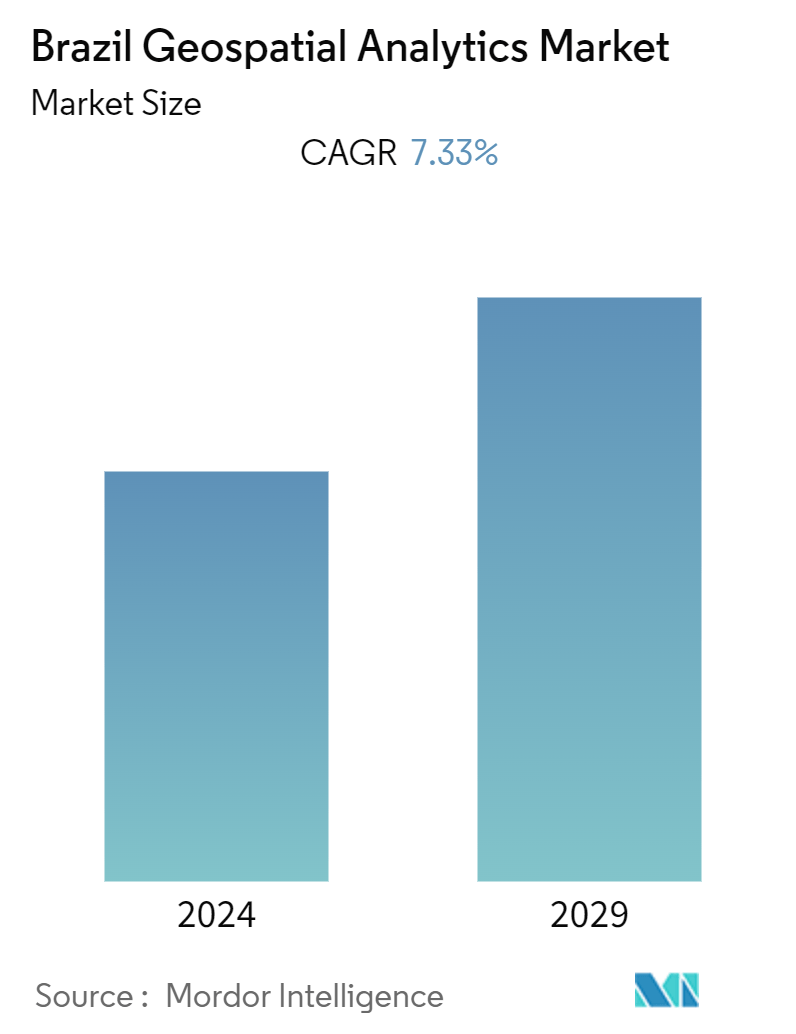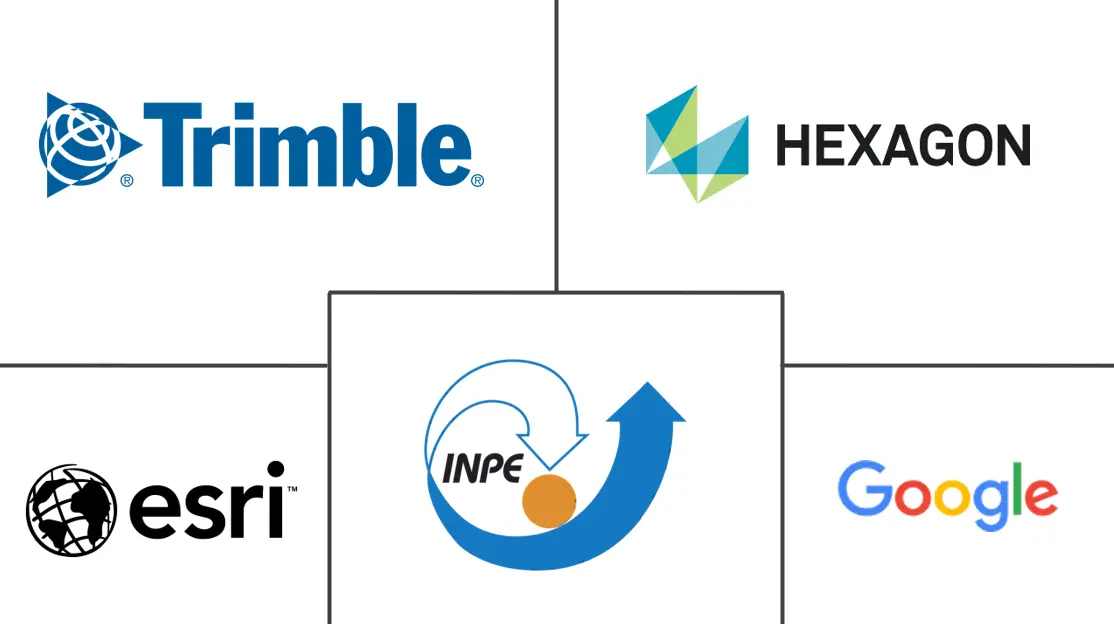Market Size of Brazil Geospatial Analytics Industry

| Study Period | 2019 - 2029 |
| Base Year For Estimation | 2023 |
| Forecast Data Period | 2024 - 2029 |
| Historical Data Period | 2019 - 2022 |
| CAGR (2024 - 2029) | 7.33 % |
| Market Concentration | Low |
Major Players
*Disclaimer: Major Players sorted in no particular order |
Brazil Geospatial Analytics Market Analysis
The Brazil Geospatial Analytics Market is expected to register a CAGR of 7.33% during the forecast period.
The growing demand for location-based services (LBS) is driving the need for accurate and real-time geospatial data. Retail, logistics, and tourism industries are leveraging geospatial analytics to optimize operations, improve customer experiences, and gain competitive advantages.
- Brazil is one of the largest agricultural producers globally, and geospatial analytics is crucial in optimizing agricultural practices. It helps farmers and agribusinesses make data-driven decisions, improve crop productivity, optimize resource allocation, and reduce environmental impacts.
- In addition, Brazil is known for its rich and diverse ecosystems, including the Amazon rainforest. Geospatial analytics could be extensively used for environmental monitoring, conservation, and resource management. It enables the assessment of deforestation, biodiversity, land use changes, and water resources. Geospatial analytics might also support sustainable environmental management practices and aids decision-making for effectively preserving and managing natural resources.
- The Brazilian government has been actively promoting the adoption of geospatial analytics across various sectors. Initiatives such as the National Plan for Geospatial Information (PING) and the National Geospatial Infrastructure (INDE) aim to enhance the availability, quality, and interoperability of geospatial data. These government-led efforts have created a favorable environment for geospatial analytics adoption and implementation.
- In addition, the integration of geospatial analytics with emerging technologies, such as big data, the Internet of Things (IoT), artificial intelligence (AI), and machine learning, is driving market growth. These technologies enable the processing, analysis, and visualization of vast amounts of geospatial data, leading to real-time monitoring, predictive analytics, and intelligent decision-making.
- Geospatial analytics relies on robust infrastructure, including reliable internet connectivity, satellite imagery, and remote sensing capabilities. In some areas of Brazil, there may be limitations in infrastructure development, hindering the seamless collection and transmission of geospatial data. Insufficient infrastructure can act as a constraint on the market's growth potential.
- Geospatial analytics aided in identifying high-risk areas and optimizing resource allocation for testing, healthcare facilities, and vaccination campaigns. At the same time, the economic downturn caused by the pandemic had an adverse impact on various industries, including the geospatial analytics sector. Budget constraints and financial uncertainties among organizations may slowed down investment and adoption of geospatial analytics solutions.
Brazil Geospatial Analytics Industry Segmentation
Geospatial analytics is the process of acquiring, manipulating, and displaying imagery and data from the geographic information system (GIS), such as satellite photos and GPS data. The specific identifiers of a street address and a zip code are used in geospatial data analytics. They are used to create geographic models and data visualizations for more accurate trends modeling and forecasting.
The Brazil geospatial analytics market is segmented by type (surface analysis, network analysis, and geovisualization), by end-user vertical (agriculture, utility and communication, defense and intelligence, government, mining and natural resources, automotive and transportation, healthcare, real estate and construction, and other end-user verticals).
The market sizes and forecasts are provided in terms of value in USD for all the above segments.
| By Type | |
| Surface Analysis | |
| Network Analysis | |
| Geovisualization |
| By End-User Vertical | |
| Agriculture | |
| Utility and Communication | |
| Defense and Intelligence | |
| Government | |
| Mining and Natural Resources | |
| Automotive and Transportation | |
| Healthcare | |
| Real Estate and Construction | |
| Other End-User Verticals |
Brazil Geospatial Analytics Market Size Summary
The Brazil geospatial analytics market is poised for significant growth, driven by the increasing demand for location-based services across various sectors such as retail, logistics, and tourism. These industries are harnessing geospatial analytics to enhance operational efficiency, improve customer experiences, and secure competitive advantages. The agricultural sector, a cornerstone of Brazil's economy, is also leveraging these analytics to optimize farming practices, boost crop yields, and manage resources sustainably. Additionally, the rich biodiversity and ecosystems in Brazil, including the Amazon rainforest, benefit from geospatial analytics for environmental monitoring and conservation efforts. Government initiatives like the National Plan for Geospatial Information and the National Geospatial Infrastructure are fostering a supportive environment for the adoption of these technologies, further propelling market growth.
The integration of geospatial analytics with emerging technologies such as big data, IoT, AI, and machine learning is a key driver of market expansion, enabling real-time data processing and intelligent decision-making. Despite challenges like infrastructure limitations in certain regions, the market is supported by robust satellite operations and government policies promoting data sharing and standardization. The geo-visualization segment, which involves interactive representation of geospatial data, is expected to capture a significant market share due to its growing importance in data analysis and decision support. The market landscape is competitive, with major players like Esri, Google, Hexagon AB, and Trimble, alongside numerous local and regional companies, all vying for market share. Collaborative efforts and continuous innovation are essential for companies to meet the evolving demands and drive the market forward.
Brazil Geospatial Analytics Market Size - Table of Contents
-
1. MARKET INSIGHTS
-
1.1 Market Overview
-
1.2 Industry Attractiveness - Porter's Five Forces Analysis
-
1.2.1 Bargaining Power of Buyers
-
1.2.2 Bargaining Power of Suppliers
-
1.2.3 Threat of New Entrants
-
1.2.4 Threat of Substitutes
-
1.2.5 Intensity of Competitive Rivalry
-
-
1.3 Industry Value Chain Analysis
-
1.4 Assessment of the Impact of COVID-19 on the Market
-
-
2. MARKET SEGMENTATION
-
2.1 By Type
-
2.1.1 Surface Analysis
-
2.1.2 Network Analysis
-
2.1.3 Geovisualization
-
-
2.2 By End-User Vertical
-
2.2.1 Agriculture
-
2.2.2 Utility and Communication
-
2.2.3 Defense and Intelligence
-
2.2.4 Government
-
2.2.5 Mining and Natural Resources
-
2.2.6 Automotive and Transportation
-
2.2.7 Healthcare
-
2.2.8 Real Estate and Construction
-
2.2.9 Other End-User Verticals
-
-
Brazil Geospatial Analytics Market Size FAQs
What is the current Brazil Geospatial Analytics Market size?
The Brazil Geospatial Analytics Market is projected to register a CAGR of 7.33% during the forecast period (2025-2030)
Who are the key players in Brazil Geospatial Analytics Market?
Esri Global, Inc., Google LLC (Alphabet Inc.), Hexagon AB, Trimble Inc. and INPE (National Institute for Space Research) are the major companies operating in the Brazil Geospatial Analytics Market.

